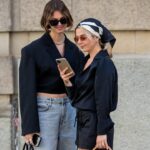The exhibition will be arranged by 12 characteristics of Black dandyism, an organizational principle informed by a 1934 Zora Neale Hurston essay, “The Characteristics of Negro Expression.” The sections will tell the story of the Black dandy’s evolution over time via not just garments and accessories, but a range of media that includes drawings, paintings, photographs, and film excerpts. The first—Ownership—showcases an enslaved person’s livery from 19th century Maryland. Jook, which was one of Hurston’s original categories and was concerned with music, dancing and pleasure, includes a pair of Zoot suits from the 1940s; while Cosmopolitanism features pieces designed by both Pharrell Williams and the late Virgil Abloh for Louis Vuitton men’s.
“The contemporary designers that are in the show are there because many of them talk about and use the history that we’re recounting as part of their design philosophies,” Miller pointed out. In some cases they also have heritage in West Africa or the Caribbean. “It’s been really interesting to see the show notes of Virgil Abloh and Grace Wales Bonner—they’re really well versed in the kinds of issues that we’re talking about in the exhibition, [issues] that are related to race and power, that are related to immigration, slavery, colonies and colonization, empowerment, joy, aesthetics.”
Bolton, for his part, believes menswear is in the midst of a renaissance. “That’s thanks not just to Black designers but also to men of style, like the male co-chairs for our Met Gala.” This year the co-chairs are Pharrell Williams, actor Colman Domingo, Formula One driver Lewis Hamilton, musician A$AP Rocky, and Anna Wintour, with basketball star Lebron James acting as honorary co-chair. “They’re all men who aren’t afraid to take risks with their self-presentation. They take advantage of classic forms, but they also remix them and break them down in really new ways,” Bolton said. “I think Black men and Black designers are very much at the forefront of this new renaissance in menswear.”
As in previous years, the exhibition will gather a group of influential collaborators, each of whom are providing distinct elements: The interdisciplinary artist Torkwase Dyson will be responsible for the conceptual design of the exhibition; Tanda Francis, who creates monumental African heads and masks seen in both public and personal spaces, is creating bespoke mannequin heads that will be produced for the show; and the artist Tyler Mitchell will be photographing the catalogue.
Read the full article here




